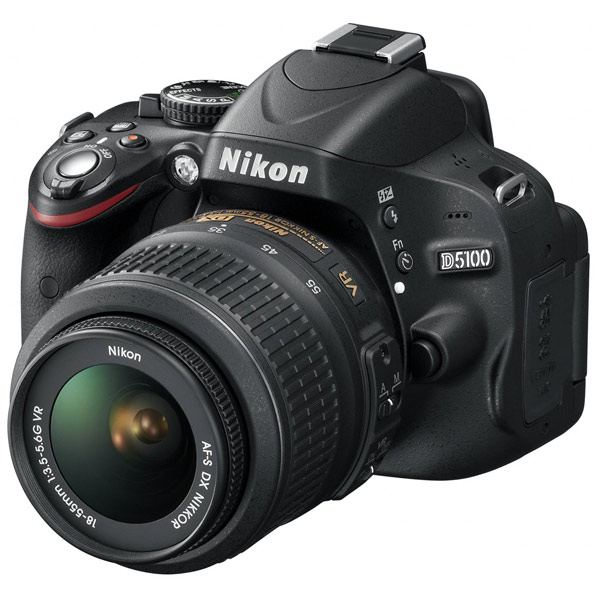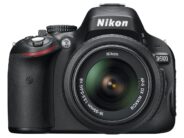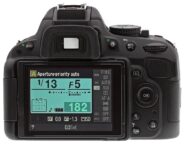Announced
Production status
System
Nikon F APS-C system cameras
- Nikon D1
- Nikon D100
- Nikon D1H
- Nikon D1X
- Nikon D200
- Nikon D2H
- Nikon D2Hs
- Nikon D2X
- Nikon D2Xs
- Nikon D300
- Nikon D3000
- Nikon D300s
- Nikon D3100
- Nikon D3200
- Nikon D3300
- Nikon D3400
- Nikon D3500
- Nikon D40
- Nikon D40X
- Nikon D50
- Nikon D500
- Nikon D5000
- Nikon D5100
- Nikon D5200
- Nikon D5300
- Nikon D5500
- Nikon D5600
- Nikon D60
- Nikon D70
- Nikon D7000
- Nikon D70s
- Nikon D7100
- Nikon D7200
- Nikon D7500
- Nikon D80
- Nikon D90
Nikon D5100
APS-C AF digital SLR camera • Discontinued
Specification
| Format: | |
| APS-C | |
Imaging sensor: | 23.6 × 15.6mm CMOS sensor |
Resolution: | 4928 × 3264 - 16 MP |
Crop factor: | 1.53x |
Sensor-shift image stabilization: | - |
| Nikon F [46.5mm] | |
| Shutter: | |
Type: | Focal-plane |
Model: | Electronically controlled |
Speeds: | 30 - 1/4000 + B |
| Exposure: | |
Exposure metering: | Through-the-lens (TTL), open-aperture |
Exposure modes: | Programmed Auto |
| Aperture-priority Auto | |
| Shutter-priority Auto | |
| Manual | |
| Physical characteristics: | |
Weight: | 560g |
Dimensions: | 128x97x79mm |
Manufacturer description
MELVILLE, N.Y. (April 5, 2011) – Today, Nikon announced the new 16.2-megapixel Nikon D5100 Digital SLR designed for those ready to artistically express themselves and need a versatile camera that can keep pace creatively. The Nikon D5100 D-SLR houses a host of new and innovative features aimed at giving photographers the tools to shatter creative constraints and tell stories with amazing image quality and stunning HD movies.
The Nikon D5100 includes features designed to enhance the shooting experience, including an impressive new 3-inch, super sharp 921,000-dot Vari-angle LCD screen and full HD (1080p) movie recording with full-time autofocus. The 16.2-megapixel D5100 is also the first Nikon D-SLR to provide in-camera effects that can be applied to both photos and movies to deliver even more creative expression.
“Now more than ever, consumers want to pack only one device with them when travelling on excursions both far away and close to home,” said Lisa Osorio, general manager of marketing at Nikon Inc. “By providing consumers with a simple path to creative freedom for both stills and movies, the Nikon D5100 is designed to become an essential camera for capturing all of life’s occasions.”
Ready for the Adventure of Life
The D5100 allows photographers of all levels to confidently execute new and creative ways to tell stories with amazing color and clarity. Whether shooting high over crowds or down low to a toddler’s point of view, the swing out style Vari-angle LCD screen makes it easy to compose and share great images. Displaying even the most subtle details with clarity, the super sharp LCD has a 1000:1 contrast ratio and 921,000-dot resolution, with the ability to rotate 180 degrees horizontally and vertically.
To further test creative boundaries, photographers can take advantage of the D5100’s in-camera Special Effects Mode. Applied to either stills or D-Movies, these innovative effects are easy to apply and add a high level of creativity and fun to the photo experience. By selecting the Effects position on the mode dial located on top of the camera, photographers can easily apply effects such as Selective Color and choose up to three different colors in a scene while the remainder of the scene is converted to monochrome. Color Sketch creates photos and a stop motion movie in a colorful sketched drawing style, while the Miniature effect records photos and high speed movies to bestow a feeling of a mini-scale scene. To record photos in extreme lighting conditions or to produce movies with a gritty appearance , the new Night Vision mode calls upon Nikon’s pro D-SLR performance to offer extreme low-light capability by enabling the camera to shoot up to a super-high 102,400 ISO. In addition to the Effects mode, users can create photos with amazing tonal range by selecting the high dynamic range (HDR) function within the camera. With this selected, the D5100 will automatically expose two consecutive images in rapid succession – one over and one underexposed up to 3EV stops to produce a finished photo with an amazing range of midtones and highlights that wouldn’t otherwise be possible in a single shot. Additionally, Active D-Lighting can be selected by itself or combined with HDR for an even more dramatic effect.
The versatile Nikon D5100 D-SLR will motivate shooters to further explore creatively with its advanced camera features including full manual controls (P,S,A,M on the mode dial) offering the ability to manage the camera’s aperture and shutter speeds. Once the photo is captured, photographers have the flexible retouch menu at their disposal to apply additional in-camera effects and editing options including color and filter effects, red eye correction and NEF (RAW) processing.
The remarkably wide ISO range of 100-6400 (expandable to a staggering 25,600 ISO), allows photographers to shoot confidently in outdoor and indoor low-light situations, even handheld with low noise. In challenging lighting conditions such as when a subject is backlit, Nikon’s Active D-lighting feature helps to keep shadows and highlights consistent for even exposures.
To further unleash creativity, the Picture Control system also affords users the choice for Standard, Neutral, Vivid, Monochrome, Portrait, or Landscape settings to apply a personal look and feel to their pictures. Additionally, the versatile Scene Modes let them choose from Portrait, Landscape, Child, Sports, Close-up or Night Portrait and more for stunning results in just about all possible lighting conditions.
Create Full HD Movies
The Nikon D5100 captures 1080p full HD movies with full-time autofocus and manual exposure control. Users can quickly switch focus modes to stay with the action through a variety of AF functions, including face priority which can track up to 35 human faces, subject-tracking and normal or wide-area autofocus. To activate D-Movie mode and Live-view, a new switch is ergonomically located on the top of the camera near the shutter button for easy access.
The D5100 D-SLR offers variable frame rates and resolutions for movies, and can record 1080p at a cinema-like 24 or 30fps, or a web-friendly 720p resolution at either 24 or 30 fps for up to 20 minutes per clip, in the AVC-HD H.264 codec. Once recorded, movie clips can be edited and trimmed in the camera to save time in post production. Whether utilizing a wireless or hot shoe mounted microphone such as the new ME-1, sound can be recorded via the stereo microphone input for professional audio results. Captured movies can be easily shared using the HDMI output, and controlled remotely with HDMI CEC compatibility.
Superior Image Quality
The 16.2-megapixel DX-format CMOS sensor is capable of capturing images that erupt with color and offer amazing sharpness and clarity to create images and full HD movies even in low-light conditions. Coupled with Nikon’s exclusive EXPEED2 image processing engine, images are brought to life with vivid colors and amazing contrast, accurate exposure, and low noise levels resulting in brilliant image quality. The EXPEED 2 engine also drives the quick 11-point AF system on the D5100 to provide rapid focus acquisition even on fast moving subjects. When shooting action, split second shutter response and four frames per second burst rate make sure no moment is missed, forever putting to rest the story of “the one that got away”.
Whether shooting lush wilderness landscapes or an urban skyline, the D5100 utilizes Nikon’s exclusive Scene Recognition System to analyze subject information from a database containing more than 30,000 images to optimize focus, exposure, i-TTL flash exposure and white balance. To assist in creating amazing imagery, the Scene Recognition System reads data from the 420-pixel 3D Color Matrix Meter RGB sensor that examines the scene’s brightness and color data then optimizes the camera’s performance prior to the actual exposure.
An entirely greater world of creativity will open up to photographers when adding versatile AF-S NIKKOR lenses to the equation. With a wide range of focal lengths and versatile features, AF-S NIKKOR lenses help to create a variety of photo perspectives to images and movies such as the ability to isolate subjects with a shallow depth of field or zoom close to the action from afar. Combining the D5100 D-SLR with NIKKOR lenses also delivers the sharpness essential for HD movies, and Nikon’s innovative Vibration Reduction (VR) II technology helps to eliminate the effects of camera shake.
New ME-1 Microphone
To address the needs of the ever growing community of shooters abandoning their video cameras for the versatility of a D-SLR, Nikon now offers the ME-1 stereo microphone. Engineered specifically for a D-SLR, the new ME-1 microphone attaches to the hot shoe and has noise dampening components designed to minimize noise resulting from AF operation. The microphone also has a low-cut filter to reduce wind and other noise not already blocked by the wind screen. Designed with D-SLR users in mind, the ME-1 is powered through the camera, and also features a cable stop to keep the cable out of the way when using the camera, and reduce instances of noise from unintentional contact. Because it utilizes a standard 3.5mm stereo jack, the ME-1 is ideal for the D5100 and other Nikon HD movie capable D-SLR’s such as the D3s, D300s, D7000, as well as the COOLPIX P7000 and any other camera with a 3.5mm stereo input jack.
Similar cameras (4)
APS-C • Auto focus • Digital • Singe-lens reflex • Nikon F mount
| Model | Shutter | Metering | Modes | Year |
|---|---|---|---|---|
| Fujifilm FinePix S1 Pro | E, 1/2000 | TTL • OA | PASM | 2000 ● |
| Fujifilm FinePix S2 Pro | E, 1/4000 | TTL • OA | PASM | 2002 ● |
| Fujifilm FinePix S3 Pro | E, 1/4000 | TTL • OA | PASM | 2004 ● |
| Fujifilm FinePix S5 Pro | E, 1/8000 | TTL • OA | PASM | 2006 ● |



